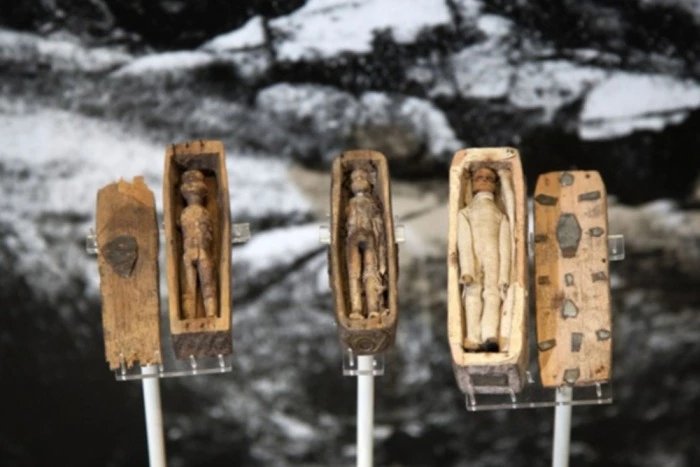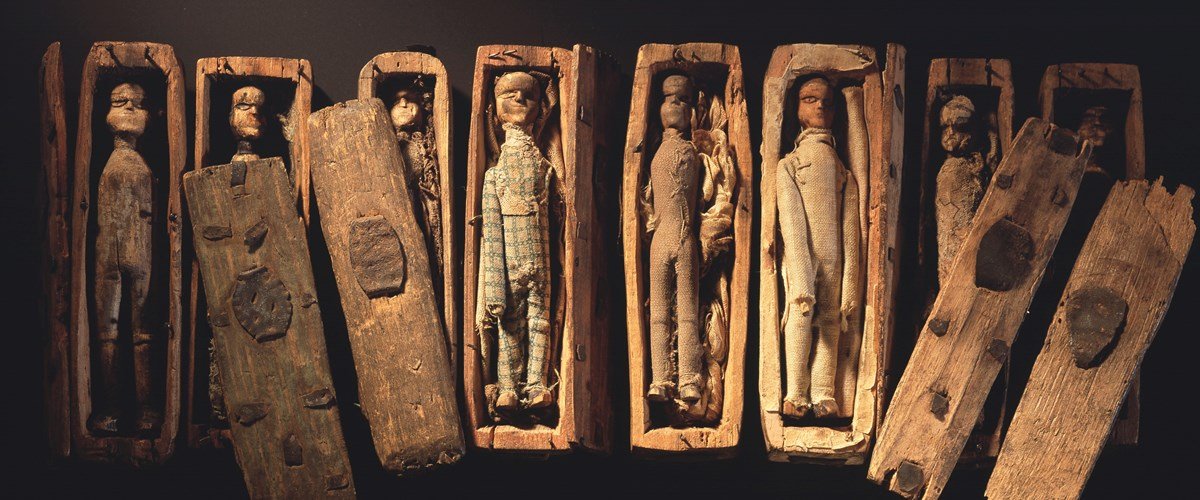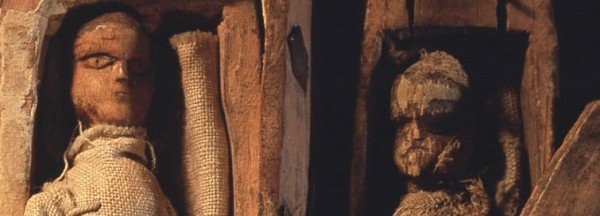17 Mysterious Miniature Coffins In Scotland Remain An Unsolved Enigma
Ellen Lloyd - AncientPages.com - Almost 200 years ago, seventeen concealed miniature coffins were discovered in a cave in Edinburgh's Arthur's Seat, Scotland. It's a curious find that, to this day, remains an unsolved enigma. No one knows who put the tiny coffins there and why.
The Discovery Of The Miniature Coffins In Edinburgh's Arthur's Seat
It all started in June 1836, when three Scottish boys hunting rabbits discovered a small cave in the rock, hidden behind three-pointed slabs of slate. Concealed within were 17 miniature coffins.
According to Charles Fort (1874-1932), an American writer and researcher specializing in anomalous phenomena the coffins were only "three or four inches long.
In the coffins were miniature wooden figures. They were dressed differently in both style and material. There were two tiers of eight coffins, and a third one started with one coffin.
Three miniature coffins are on display in the National Museum of Scotland. Image credit: The National Museum of Scotland
The coffins had been deposited singly, in the little cave, and at intervals of many years. In the first tier, the coffins were quite decayed, and the wrappings had moldered away. In the second tier, the effects of age had not advanced so far. And the top coffin was relatively recent looking."
On July 16, 1836, the Scotsman reported that several figures were either badly damaged or lost altogether as the decrepit-looking cache provided convenient fodder for the boys to pelt one another with. Fortunately, some of the coffins were still intact, and they were sold to Robert Frazier, a South Andrews Street jeweler and private collector, where they remained until being donated to the National Museum of Scotland in 1901. Only eight figures, in varying states of decay, survive.
In Whose Image Were The Carved Figures Made?
The human effigies were all dressed in different garments. They must have been created to represent other individuals.
According to the Scotsman, the figures "were dressed from head to foot in cotton clothes, and decently laid out with a mimic representation of all the funereal trappings which usually form the last habiliments of the dead."
Ever since the coffins were discovered, experts and non-specialists alike have put forward several interesting and sometimes even incredible theories that attempt to explain who placed the artifacts in the cave and why.
Scotland has long been where many people were, and some still are superstitious.
The miniature coffins are still an unsolved mystery. Image credit The National Museum of Scotland
Satanic spell-manufactory!' cried The Scotsman, the first paper to report the tale, in an article published on July 16, 1836:
"Our own opinion would be – had we not some years ago abjured witchcraft and demonology – that there are still some of the weird sisters hovering about Mushat's Cairn [sic] or the Windy Gowl, who retain their ancient power to work the spells of death by entombing the likenesses of those they wish to destroy.
Later different theories were presented. Some attempted to explain the existence of the coffins as a result of witchcraft while others suggested that sailors perhaps kept them to ward off death.
Another widely held belief is that each of the figures was designed to commemorate the victims of the infamous serial killers Burke and Hare. The murderous duo had ended the lives of seventeen Edinburgh citizens less than a decade before the boys' discovery on Arthur's Seat.
According to the National Museum of Scotland, "the figures all appear to be made by the same hand, although it's possible the coffins were crafted by two different people.
A close-up of two of Edinburgh's mysterious miniature dolls. Are these intended to be the faces of two victims of the notorious bodysnatchers Burke and Hare? Credit: National Museum of Scotland.
Some of the materials and tools used – wood, iron embellishments, nails, a sharp, hooked knife – indicate the coffins could have been fashioned by a shoemaker.
The figures seem to form a set, and their upright bearing, flat feet, and swinging arms suggest they may have been toy soldiers. Their eyes are open, making it unlikely they were originally designed as corpses.
Some of the figures are missing their arms – perhaps removed so that they would fit in the coffins.
The fabric the little bodies are dressed in dates from the early 1830s, so they hadn't lain buried for more than six years."
Today, the remaining eight coffins and their contents are on display at the National Museum of Scotland on Chambers Street.
Written by Ellen Lloyd – AncientPages.com
Updated on November 4, 2022
Copyright © AncientPages.com & Ellen Lloyd All rights reserved. This material may not be published, broadcast, rewritten or redistributed in whole or part without the express written permission of AncientPages.com and Ellen Lloyd
Expand for referencesMore From Ancient Pages
-
 Will Egypt be able to buy back the 4500-year-old statue of Sekhemka?
Artifacts | Aug 26, 2015
Will Egypt be able to buy back the 4500-year-old statue of Sekhemka?
Artifacts | Aug 26, 2015 -
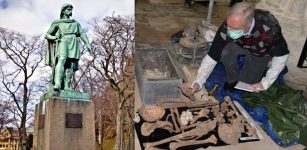 Mystery Of Viking Ruler Rollo Continues – Surprising Discovery In Ancient Grave
Archaeology | Jan 22, 2017
Mystery Of Viking Ruler Rollo Continues – Surprising Discovery In Ancient Grave
Archaeology | Jan 22, 2017 -
 Mysterious Visitors From Other Realms And Enigma Of Atmospheric Phenomena
Featured Stories | Jul 19, 2018
Mysterious Visitors From Other Realms And Enigma Of Atmospheric Phenomena
Featured Stories | Jul 19, 2018 -
 Ancient Roman Wine Was Spicy And Smelled Like Toast – Dolia Vessels Reveal
Archaeology | Jan 25, 2024
Ancient Roman Wine Was Spicy And Smelled Like Toast – Dolia Vessels Reveal
Archaeology | Jan 25, 2024 -
 DNA From Mysterious Hominin In China Suggests Native Americans’ East Asian Roots
Archaeology | Jul 14, 2022
DNA From Mysterious Hominin In China Suggests Native Americans’ East Asian Roots
Archaeology | Jul 14, 2022 -
 Strange Case Of The ‘Impossible’ Glove Remains Unexplained – The Discovery – Part 1
Featured Stories | May 24, 2019
Strange Case Of The ‘Impossible’ Glove Remains Unexplained – The Discovery – Part 1
Featured Stories | May 24, 2019 -
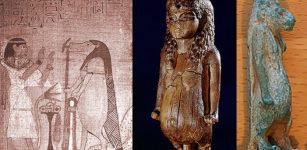 Taweret – Powerful Egyptian Hippopotamus ‘Household Goddess’ Guarded Childbirth, House, Sleep And Dispelled Evil Forces
Egyptian Mythology | Jul 16, 2018
Taweret – Powerful Egyptian Hippopotamus ‘Household Goddess’ Guarded Childbirth, House, Sleep And Dispelled Evil Forces
Egyptian Mythology | Jul 16, 2018 -
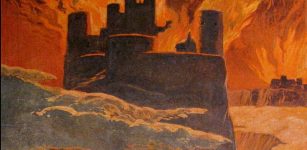 Ragnarok In Norse Mythology – The Doom Of The Gods And Apocalyptic Record Of The Coming Comet
Featured Stories | Jun 30, 2014
Ragnarok In Norse Mythology – The Doom Of The Gods And Apocalyptic Record Of The Coming Comet
Featured Stories | Jun 30, 2014 -
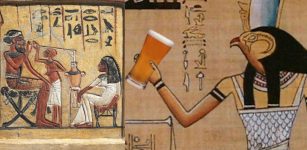 Beer Was Used As Medicine And Payment In Ancient Egypt
Ancient History Facts | Feb 11, 2018
Beer Was Used As Medicine And Payment In Ancient Egypt
Ancient History Facts | Feb 11, 2018 -
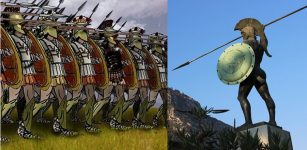 Sparta And Legendary King Leonidas: The Heroes Of Thermopylae
Featured Stories | Jul 18, 2018
Sparta And Legendary King Leonidas: The Heroes Of Thermopylae
Featured Stories | Jul 18, 2018 -
 King Khufu’s 4,600-Year-Old Solar Boat Has Been Transported To The Grand Egyptian Museum
Archaeology | Aug 9, 2021
King Khufu’s 4,600-Year-Old Solar Boat Has Been Transported To The Grand Egyptian Museum
Archaeology | Aug 9, 2021 -
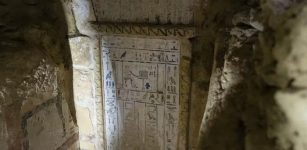 Archaeologists Have Discovered A Mummy Wrapped In Gold – Here’s What It Tells Us About Ancient Egyptian Beliefs
Featured Stories | Feb 7, 2023
Archaeologists Have Discovered A Mummy Wrapped In Gold – Here’s What It Tells Us About Ancient Egyptian Beliefs
Featured Stories | Feb 7, 2023 -
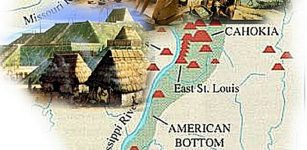 Unsolved Mysteries Of Cahokia – What Really Happened With The Large Metropolis?
Civilizations | Jan 15, 2015
Unsolved Mysteries Of Cahokia – What Really Happened With The Large Metropolis?
Civilizations | Jan 15, 2015 -
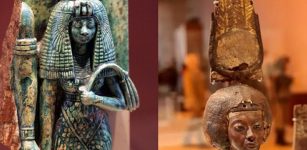 Life And Legacy Of Queen Tiye, Mother Of Akhenaten – Was She Egyptian Or Nubian?
Featured Stories | Jul 20, 2018
Life And Legacy Of Queen Tiye, Mother Of Akhenaten – Was She Egyptian Or Nubian?
Featured Stories | Jul 20, 2018 -
 Hippocrates Didn’t Write The Oath, So Why Is He The Father Of Medicine?
Featured Stories | Oct 7, 2015
Hippocrates Didn’t Write The Oath, So Why Is He The Father Of Medicine?
Featured Stories | Oct 7, 2015 -
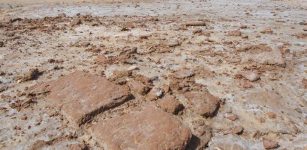 Ancient Trade Routes Between Iran And Mesopotamia – Uncovered
Archaeology | Dec 4, 2015
Ancient Trade Routes Between Iran And Mesopotamia – Uncovered
Archaeology | Dec 4, 2015 -
 Teutonic Knights – Facts And History About The Christian Military Order
Featured Stories | Feb 21, 2019
Teutonic Knights – Facts And History About The Christian Military Order
Featured Stories | Feb 21, 2019 -
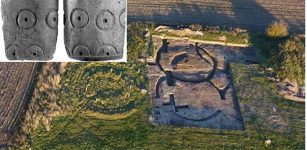 Dazzling Time Capsule Of Unique Iron Age Artifacts And Celtic Roundhouses Discovered In England
Archaeology | Mar 15, 2022
Dazzling Time Capsule Of Unique Iron Age Artifacts And Celtic Roundhouses Discovered In England
Archaeology | Mar 15, 2022 -
 Discovery At Fujiwarakyu Palace Complex Offers Better Glimpse Of 7th-Century Japan
Archaeology | Oct 21, 2015
Discovery At Fujiwarakyu Palace Complex Offers Better Glimpse Of 7th-Century Japan
Archaeology | Oct 21, 2015 -
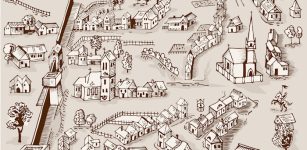 Wolstenholme Towne: Lost Virginia Settlement – Destroyed, Abandoned And Forgotten
Featured Stories | Jun 26, 2018
Wolstenholme Towne: Lost Virginia Settlement – Destroyed, Abandoned And Forgotten
Featured Stories | Jun 26, 2018

